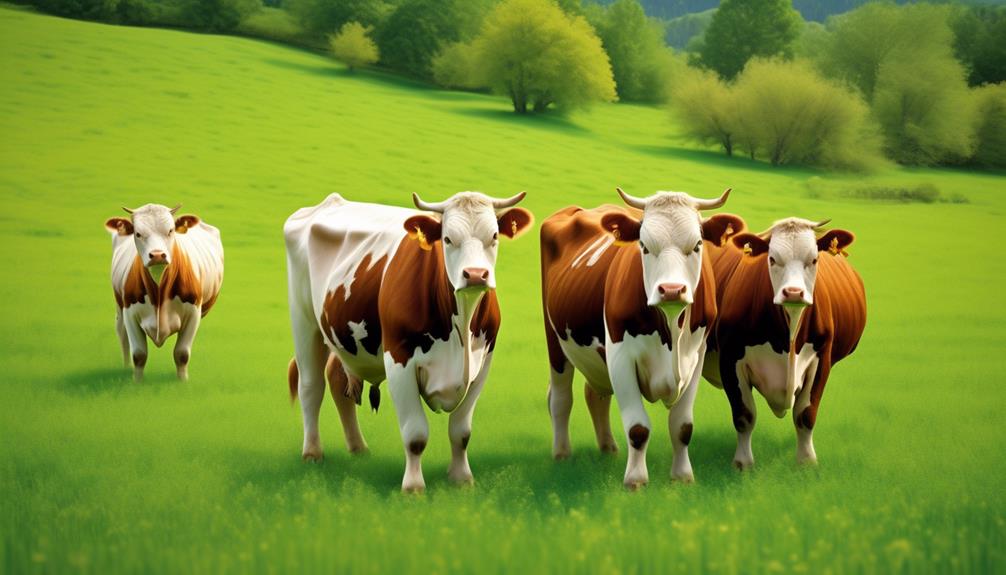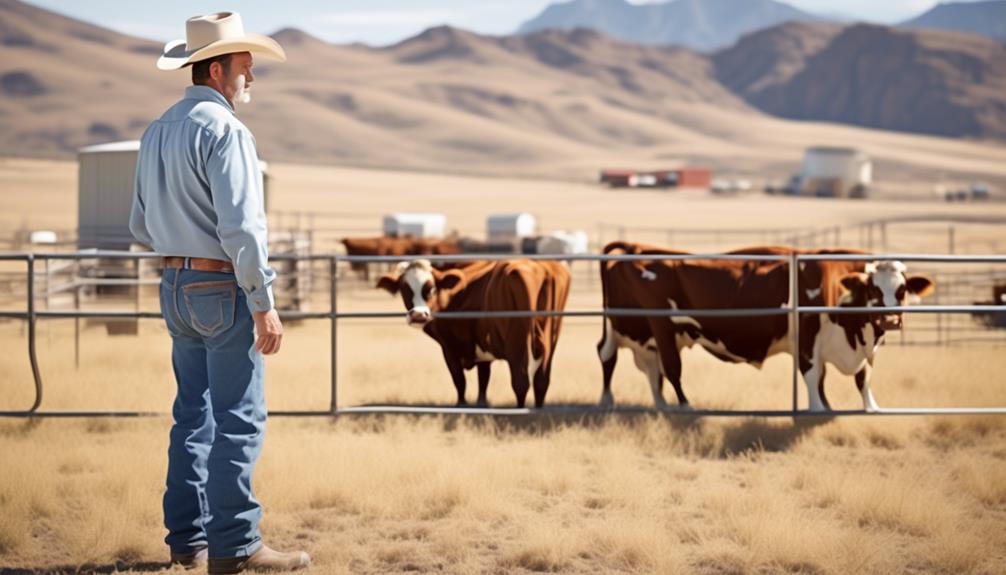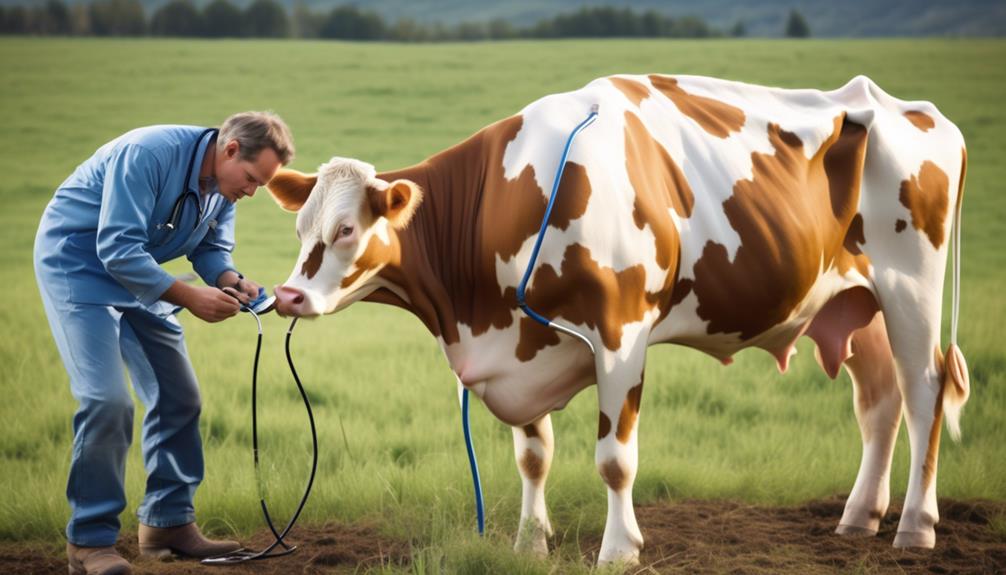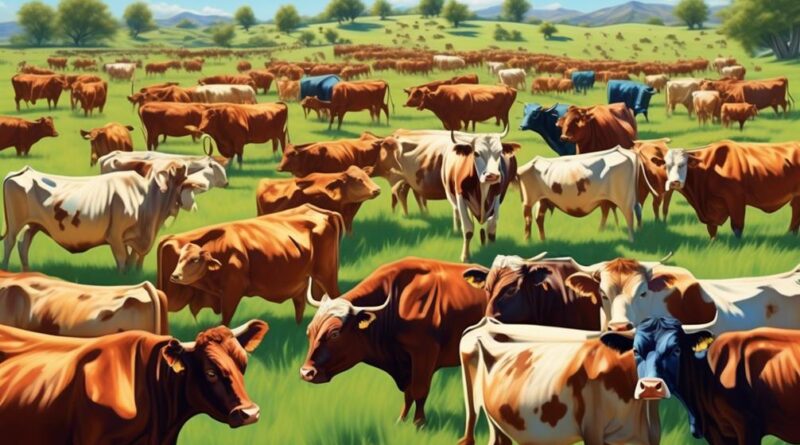4 Tips for Boosting Cattle Fertility
When it comes to boosting cattle fertility, think of your herd as a well-oiled machine. Just like any complex system, the key lies in maintaining various components at their peak condition to ensure optimal performance. From nutrition to breeding management, there are several factors that can significantly impact the fertility of your cattle.
But how do you ensure that you're addressing all the necessary aspects to maximize fertility? This discussion will provide you with four essential tips to help you achieve just that.
Nutritious Diet

To boost cattle fertility, ensure that they're receiving a balanced and nutrient-rich diet. Feed requirements play a crucial role in reproductive nutrition for cattle. Providing your cattle with the right mix of nutrients is essential for boosting their fertility.
High-quality forage, such as alfalfa or clover, can provide the necessary protein and energy levels needed for optimal reproductive function. Additionally, supplementing with grains like corn or barley can help meet their energy requirements, supporting overall reproductive health.
It's important to understand the specific nutritional needs of your cattle based on their age, breed, and reproductive status. For example, lactating cows have increased energy demands, so adjusting their diet to include more concentrated feed can support their reproductive capabilities. Monitoring body condition scores can also help determine if your cattle are receiving adequate nutrition. Maintaining an optimal body condition score of 5 to 6 is ideal for maximizing fertility.
Incorporating mineral supplements, such as calcium, phosphorus, and magnesium, is vital for reproductive nutrition. These minerals aid in maintaining hormonal balance and supporting the development of healthy embryos.
Additionally, ensuring access to clean, fresh water at all times is crucial for reproductive success.
Regular Exercise
Ensure that your cattle are engaging in regular exercise to complement their nutritious diet and further enhance their fertility. Regular physical activity benefits cattle in various ways, contributing to their overall well-being and reproductive health. Here are some essential tips to consider when incorporating exercise into your cattle management routine:
- Establish an Exercise Routine: Just like humans, cattle benefit from a consistent exercise routine. Set aside specific times for exercise, such as grazing in open pastures or engaging in purposeful physical activities.
- Encourage Natural Movement: Allow your cattle to engage in natural movements by providing ample space for them to roam and explore. This not only promotes physical activity but also reduces stress levels, positively impacting their fertility.
- Incorporate Play Elements: Introduce play elements in the cattle's environment to encourage movement and exercise. Simple additions such as sturdy toys or structures can stimulate physical activity and prevent boredom.
- Monitor Activity Levels: Keep track of your cattle's activity levels to ensure they're getting enough exercise. This can be achieved through regular observation or by utilizing technology such as activity trackers designed for livestock.
Proper Breeding Management

Implement proper breeding management techniques to maximize cattle fertility and reproductive success.
Reproductive timing is crucial in cattle breeding to ensure optimal conception rates. Understanding the estrous cycle of cows is essential for successful breeding. By closely monitoring the signs of estrus such as increased activity, mucus discharge, and standing heat behavior, you can accurately determine the best time for breeding. Utilizing methods such as heat detection patches or electronic estrus detection systems can aid in identifying the most fertile period for mating.
Moreover, employing appropriate breeding techniques is vital for enhancing fertility. Artificial insemination (AI) is a popular method that allows for the use of high-quality semen from genetically superior sires, thereby improving the overall genetic potential of the herd. Additionally, natural breeding through controlled mating can also be effective when managed correctly. Ensuring the presence of healthy, fertile bulls and maintaining a suitable bull-to-cow ratio is imperative for natural breeding success.
Furthermore, proper nutrition and healthcare play a significant role in breeding management. Providing cows with a balanced diet rich in essential nutrients, minerals, and vitamins is crucial for reproductive health. Regular health check-ups, vaccinations, and parasite control are also essential to ensure that the cattle are in optimal breeding condition.
Minimizing Stress
Monitoring the signs of stress in your cattle is essential for maintaining their reproductive health and fertility. Stress reduction is crucial for optimizing cattle fertility. Here are some tips to help minimize stress and promote reproductive health:
- Behavioral Management: Observing the behavior of your cattle can provide valuable insights into their stress levels. Aggressive behavior, decreased feed intake, and excessive vocalization are all signs of stress. Implementing low-stress handling techniques and providing a calm and consistent environment can help alleviate stress and promote reproductive health.
- Environmental Impact: The environment plays a significant role in the stress levels of cattle. Factors such as extreme weather conditions, overcrowding, inadequate shelter, and noisy surroundings can all contribute to heightened stress levels. Providing comfortable and well-ventilated housing, access to clean water, and ample space for movement can help reduce environmental stressors and improve fertility.
- Nutritional Considerations: Ensuring that your cattle receive a balanced and nutritious diet is essential for minimizing stress and optimizing reproductive health. Proper nutrition can help bolster their resilience to stress and support overall well-being, including reproductive function.
- Routine Monitoring: Regularly monitoring your cattle for signs of stress and promptly addressing any issues that arise is crucial for maintaining their reproductive health. By staying vigilant and proactive, you can identify and mitigate potential stressors before they impact fertility.
Monitoring Health

Maintaining the health of your cattle through regular observation and proactive care is essential for ensuring optimal reproductive function and fertility. Monitoring the reproductive performance and fertility of your cattle is crucial for maximizing breeding success and overall herd productivity. To effectively monitor the health of your cattle and their reproductive performance, it's important to establish a comprehensive health program in consultation with a veterinarian. Regular health check-ups, including pregnancy checks and reproductive tract evaluations, are essential components of fertility monitoring.
Keep a close eye on the body condition of your cattle, as it directly impacts their reproductive performance. Ensure that they're receiving a balanced diet and are free from any nutritional deficiencies that could hinder fertility. Additionally, monitor for signs of diseases or infections that can negatively affect reproductive health. Implementing a vaccination program and maintaining a clean and hygienic environment can significantly contribute to the overall health and fertility of your cattle.
Regularly observe the behavior and estrus cycles of your cattle to identify any abnormalities or irregularities that may signal underlying health issues. By staying vigilant and proactive in monitoring the health and reproductive performance of your cattle, you can address any concerns promptly and prevent potential fertility challenges.
Genetic Selection
When considering genetic selection for your cattle, focus on identifying desirable traits that align with your breeding goals. This is crucial for achieving a successful breeding program and maintaining a productive herd. Here are some key points to consider when it comes to genetic selection:
- Breeding Strategies: Implementing effective breeding strategies is essential for maximizing the genetic potential of your cattle. Consider incorporating methods such as crossbreeding or selective breeding to enhance specific traits within your herd.
- Herd Management: Proper herd management plays a significant role in genetic selection. Ensure that your cattle are provided with optimal nutrition, healthcare, and living conditions to support their genetic potential for fertility and overall productivity.
- Trait Selection: Identify the specific traits that are most important for your breeding goals. Whether it's improved fertility, disease resistance, or growth rate, selecting the right traits will contribute to the overall success of your breeding program.
- Genetic Diversity: Maintaining genetic diversity within your herd is vital for its long-term health and productivity. Avoid over-reliance on a limited gene pool and strive to introduce new genetic lines to prevent inbreeding and promote overall resilience in your herd.
Environmental Considerations

To ensure the continued success of your breeding program and the overall health of your herd, it's essential to consider the impact of environmental factors on cattle fertility and genetic potential.
Environmental impact plays a significant role in the reproductive performance of cattle. Climate considerations, such as temperature, humidity, and seasonal changes, can all influence fertility.
High temperatures, for instance, can lead to heat stress in cattle, affecting sperm production in bulls and causing irregular estrous cycles in cows. Providing adequate shade and cooling systems during hot weather can mitigate these effects. Conversely, extreme cold can also impact fertility, so it's important to ensure that cattle have access to shelter during winter months.
In addition to temperature, humidity levels should be monitored as excessive humidity can also lead to heat stress. Proper ventilation in barns or housing facilities can help manage humidity levels, thus supporting optimal fertility in your herd.
Moreover, seasonal changes can affect the availability and quality of forage, which in turn impacts the nutritional status of the cattle. It's crucial to adjust feeding strategies to account for these variations to ensure that your cattle receive the necessary nutrients for reproductive success.
Hormonal Intervention
Implementing hormonal intervention can significantly enhance the reproductive efficiency of your cattle. By carefully managing reproductive hormones, you can greatly improve the fertility and overall productivity of your herd.
Here are a few key points to consider when it comes to hormonal intervention:
- Reproductive Hormones: Understanding the role of reproductive hormones is crucial in effectively implementing hormonal intervention. By manipulating these hormones, you can optimize the timing of breeding and increase the chances of successful conception.
- Effectiveness: Hormonal intervention has been proven to be highly effective in enhancing fertility in cattle. When used correctly, it can help overcome reproductive challenges and improve the overall breeding success rate within your herd.
- Hormonal Balance: Maintaining the right hormonal balance is essential for maximizing fertility impact. It's important to work closely with a veterinarian or animal reproductive specialist to ensure that the hormonal interventions are tailored to the specific needs of your cattle.
- Fertility Impact: Hormonal interventions can have a direct impact on the fertility of your cattle. By carefully monitoring and adjusting hormone levels, you can significantly increase the likelihood of successful pregnancies and ultimately improve the overall reproductive performance of your herd.
Frequently Asked Questions
What Are Some Common Signs of Infertility in Cattle That Producers Should Be Aware Of?
You should watch for common signs of infertility in cattle, such as irregular estrus cycles or abnormal discharge. Diagnostic tests like reproductive tract scoring and semen evaluation can help assess fertility issues and guide management decisions.
How Can Producers Determine the Best Breeding Season for Their Cattle?
To determine the best breeding season for your cattle, consider factors affecting fertility like nutrition, health, and weather. Consult with a veterinarian and monitor the cows' reproductive cycles for the best breeding practices.
Are There Any Specific Supplements or Additives That Can Help Improve Cattle Fertility?
To improve cattle fertility, consider using supplement options and nutritional additives. These can positively impact reproductive health. It's essential to consult with a veterinarian to determine the best choices for your specific herd.
What Role Do Environmental Factors Play in Cattle Fertility and How Can Producers Address Them?
To improve cattle fertility, focus on environmental management. Ensure your cattle have proper nutrition. Address factors like temperature, humidity, and stress. Providing a comfortable and well-balanced environment is crucial for meeting their nutritional requirements and enhancing fertility.
Are There Any Emerging Technologies or Techniques That Can Aid in Improving Cattle Fertility?
To boost cattle fertility, consider emerging technologies and reproductive techniques. Genetic advancements and reproductive health play key roles. Stay informed about new methods and tools that can help improve your herd's fertility and overall productivity.
Conclusion
So, if you want to boost cattle fertility, make sure to provide a nutritious diet, regular exercise, proper breeding management, and minimize stress.
Monitor their health, consider genetic selection, environmental factors, and hormonal intervention.
By taking these steps, you can improve the overall fertility of your cattle and increase the chances of successful breeding.
